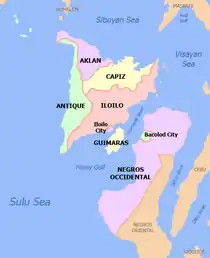Metro Bacolod
The Bacolod Metropolitan Area (Hiligaynon: Kaulohan nga Bacolod; Tagalog: Kalakhang Bacolod), simply known as Metro Bacolod, is the 8th-most populous and the 6th-most densely populated metropolitan area out of the 12 metropolitan areas in the Philippines. This metropolitan area as defined by the National Economic and Development Authority (NEDA) has an estimated population of 791,019 inhabitants as of the 2015 official census by the Philippine Statistics Authority. [3]
Metropolitan Bacolod
Kaulohan nga Bacolod | |
|---|---|
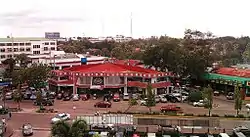 North Drive Bacolod | |
 Seal | |
 Political map of Metro Bacolod | |
| Country | Philippines |
| Region | Western Visayas (Region VI) |
| Province | Negros Occidental |
| Cities | Bacolod Silay Talisay |
| Legislative Districts | Lone District of Bacolod City 3rd District of Negros Occidental |
| Barangays | 128[1] |
| Largest city | Bacolod |
| Other cities | Silay City, Talisay City |
| Government | |
| • Type | Metropolis |
| Area | |
| • Total | 578.65 km2 (223.42 sq mi) |
| Population | |
| • Total | 791,019 |
| • Density | 1,400/km2 (3,500/sq mi) |
| Time zone | UTC+8 (Philippine Standard Time) |
The metropolitan area is centered on Bacolod, the provincial capital, and the component cities of Silay and Talisay, all three cities located in the province of Negros Occidental. As of 2005, Metro Bacolod has relatively high GDP shares, contributed ₱88,056,250 or about 7.3% of the country's gross domestic product (GDP). Metro Bacolod is among those identified by the National Framework for Physical Planning: 2001–2030 as one of the country’s industrial, financial and technological centers. It is ranked 4th among the six regions in terms of GDP contributions in 2005.[4]
However, under the initiative of the Bacolod City Government, the definition has been expanded to include the City of Bago and Municipality of Murcia, bring the total population to 1,043,286 based on the 2015 official census of the Philippine Statistics Authority.[5]
Cities
All of the cities of Metro Bacolod are located in the province of Negros Occidental.
| City | Population (2015) [3] | Pop. density (per km²) | Area (km²) | Income Class | Legal Class | Zip Code |
|---|---|---|---|---|---|---|
| Bacolod | 561,875 | 3,500 | 162.67 | 1st class | Highly Urbanized City | 6100 |
| Talisay | 102,214 | 510 | 201.18 | 4th | Component City | 6115 |
| Silay | 126,930 | 590 | 214.80 | 3rd | Component City | 6116 |
Transportation

Airport
Bacolod–Silay International Airport is located in Silay City. Metro Bacolod is approximately 1hr 13mins by air from Ninoy Aquino International Airport and approximately 30–45 minutes by air from Mactan–Cebu International Airport. Commercial Airlines serving the metropolitan area are Philippine Airlines, Cebu Pacific Air, PAL Express and Cebgo.
Roads
Bacolod City has two main roads, Lacson Street to the north and Araneta Street to the south. The city has a good traffic plan lay-out and very seldom has traffic jams. The streets in the downtown area are one way, making Bacolod free from traffic congestion. Recently, Bacolod City is experiencing an increase in traffic congestion due to an increase in number of vehicles and a perceived lack of implementation of traffic rules by the local government.
Seaports
Banago Wharf and BREDCO Port are the vessels entry point in Bacolod. It has daily access to Iloilo, with different shipping lines such as 2GO Travel(as relaunched in 2012), Weesam Express, Ocean Jet, Montenegro Lines, Jomalia Shipping and Tri Star megalink. There are also access routes to Puerto Princesa City via Iloilo City, Cagayan de Oro City, General Santos City, Zamboanga City, Cotabato City, Butuan City via Cagayan de Oro route, Dipolog City Iligan City, Ozamiz City, and Surigao City via Cagayan de Oro route. As of 2012 SuperFerry and Negros Navigation was relaunched into 2GO Travel routes from Bacolod going Manila, Iloilo and Cagayan de Oro. Bacolod City is 18–23 hours from the Port of Manila, 2–3 hours from Dumangas Port and 45 minutes- 1hr from the Port of Iloilo.
Gallery
Bacolod
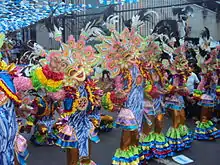 MassKara Festival Street Dancing
MassKara Festival Street Dancing Fountain of Justice and downtown Bacolod
Fountain of Justice and downtown Bacolod Front view of Bacolod City New Government Center
Front view of Bacolod City New Government Center Back view of Bacolod City New Government Center
Back view of Bacolod City New Government Center
 The Riverside Medical Center Inc. Medical Arts Building along BS Aquino Drive
The Riverside Medical Center Inc. Medical Arts Building along BS Aquino Drive Philippine National Bank building, along Lacson Street
Philippine National Bank building, along Lacson Street SM City Bacolod during PyroMagic 2007
SM City Bacolod during PyroMagic 2007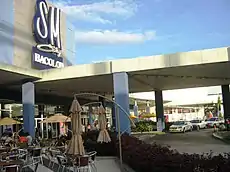 SM City Bacolod North Wing
SM City Bacolod North Wing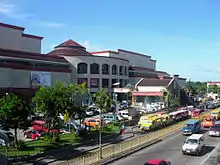 Robinsons Place Bacolod, along Lacson Street in Barangay Mandalagan
Robinsons Place Bacolod, along Lacson Street in Barangay Mandalagan La Salle Coliseum of the University of St. La Salle
La Salle Coliseum of the University of St. La Salle UNO-Recoletos façade
UNO-Recoletos façade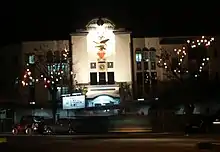 Colegio San Agustin - Bacolod Administration Building Facade
Colegio San Agustin - Bacolod Administration Building Facade
 A view of the Capitol Park and Lagoon looking towards the Negros Occidental Provincial Capitol building
A view of the Capitol Park and Lagoon looking towards the Negros Occidental Provincial Capitol building Panaad Park and Stadium
Panaad Park and Stadium L'Fisher Chalet
L'Fisher Chalet
Silay

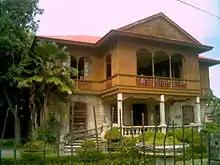
 Silay City Ancestral Houses
Silay City Ancestral Houses San Diego Pro-cathedral
San Diego Pro-cathedral Sugarcane fields, near the City Center
Sugarcane fields, near the City Center Pre-departure area Bacolod–Silay International Airport
Pre-departure area Bacolod–Silay International Airport
Talisay
 The Ruins
The Ruins Statue of Andres Bonifacio
Statue of Andres Bonifacio The District - North Point at Ayala North Point
The District - North Point at Ayala North Point Campuestohan Highland Resort
Campuestohan Highland Resort
Proposed developments
Former Bacolod Mayor Monico Puentevella proposed the creation of Metro Bacolod Development Authority (MBDA) which is now supported by the Negros Occidental Governor Alfredo Marañon Jr. The cities of Bacolod, Talisay, Silay, Bago, and the municipality of Murcia will be the components of MBDA. Once approved, Metro Bacolod will have a total population of 1,058,203. [6]
Metro Bacolod Chamber of Commerce and Industry (MBCCI) president Frank Carbon believes that turning Bacolod and surrounding places into a metropolitan area is an essential factor in progress. He envisions Metro Bacolod to be composed of Bacolod, Silay, Talisay and Bago cities, as well as Murcia and Salvador Benedicto towns. There is a need to create a master plan for Metro Bacolod and the Metro Bacolod Development Authority (MBDA) which will help this capital city and nearby areas achieve their long-term goals and boost their business sector, Carbon said. [7]
This plan divides the cities and municipalities to the following industries:
- Bacolod: Capital city, metropolitan core and financial center
- Bago: Industrial center
- Murcia: Agro-tourism hub
- Silay City: Heritage and cultural hub
- Talisay City: Village city and sub-urban development
- Salvador Benedicto: Summer capital
References
- Government of the Philippines. "Total Population by Province, City, Municipality and Barangay: as of August 1, 2007 (Region VI – Western Visayas)" Archived February 15, 2010, at the Wayback Machine, Philippine Statistics Authority, Republic of the Philippines, Retrieved on July 7, 2010.
- "List of Cities". Archived from the original on April 29, 2011. Retrieved July 7, 2010.
- Census of Population (2015). Highlights of the Philippine Population 2015 Census of Population. PSA. Retrieved June 20, 2016.
- "Building Globally Competitive Metro Areas in the Philippines" (PDF). National Economic and Development Authority. August 30, 2007. Archived from the original (PDF) on October 4, 2013. Retrieved February 6, 2014.
- http://www.visayandailystar.com/2018/February/03/topstory10.htm
- "Archived copy". Archived from the original on August 11, 2013. Retrieved August 7, 2013.CS1 maint: archived copy as title (link)
- http://panaynewsphilippines.com/2014/08/28/biz-leader-pushes-metro-bacolod/
